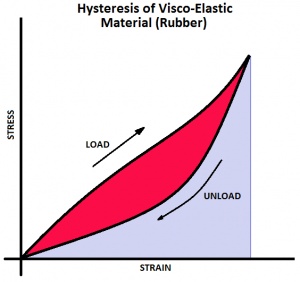Hysteresis is defined as “absorption of energy during the deformation of a viscoelastic material”
When Rubber Caster Wheels are compressed (stressed) some of the energy is absorbed by the material. This absorption of energy is known as Hysteresis. This can be demonstrated on the below Stress/Strain Graph.

As can be seen on the curve, the “Load” cycle follows a different path to the “Unload” cycle. This difference is due to the energy which is absorbed during the Loading Cycle. The amount of energy lost is equal to the area of the graph coloured Red – This is called Hysteresis.
The Energy returned is shown under the “Unload” line, coloured in Blue.
The total area of the Hysteresis (Red) and the Energy Returned (Blue) equals the total sum of energy used to deform the product. The Ratio between the total sum of the energy used and the Hysteresis area, determine the percentage Hysteresis (also known as Damping Factor).
Hysteresis can have positive and negative effects depending on the application and desired characteristics of a product.
If you consider a Rubber Shock Absorber, a high level of Hysteresis would be desirable as it results in the impact or shock force being absorbed. The opposite of Hysteresis is called Resilience. If the Rubber Shock absorber has low Hysteresis, hence high Resilience, the impacting object would be rebounded off the Shock Absorber rather than being absorbed.
For Caster Wheels & Pneumatic Wheels Hysteresis is considered a negative characteristic. The primary reason is that the kinetic energy absorbed is converted into heat. Heat results in degradation of the rubber caster wheel which may result in reduced fatigue life or even catastrophic failure of the wheel.
Secondly, Hysteresis results in an increase of roll resistance of tires & wheels, which in most cases is an undesired effect.
Firstly, it is important to note that all viscoelastic materials including rubber have some level of Hysteresis.
As a general guide, a high grade natural rubber may have between 5-10% Hysteresis, a commercial grade natural rubber may have between 20-30% Hysteresis, whereas a high damped Butyl may have 40-70% Hysteresis.
Hysteresis is caused by internal friction of the cross-linked molecules rubber against each other during the stress of the material. The friction absorbs the energy and converts it into heat.
The base polymer is the primary determining factor of the level of Hysteresis. Natural Rubber has a relatively low level of Hysteresis, whilst a synthetic material such as Butyl has a high level of Hysteresis.
Therefore as part of the initial design of a product the material selection is critical.
Secondly, the compounding of a material can have a significant effect on Hysteresis. – Compounding is the mixing of the Raw Rubber with various additives, chemical and fillers to improve other mechanical properties such as Ozone Resistance.
Different formulas will provide different levels of Hysteresis. For example a high level of raw rubber content will reduce Hysteresis, whilst a lower level will increase Hysteresis. This is where commercial considerations are made due to the high cost of high rubber content materials.
The fillers that are used can also have a big effect on Hysteresis level. For most materials Carbon Black is used to reinforce the material and increase its tensile strength. The size of the carbon black particles can affect the Hysteresis. Alternatively it is common to find cheaper fillers such as Clay or Calcium carbonate used in place of some of the Carbon Black, both of which increase Hysteresis.
It is therefore important to consider that whilst most commercial rubbers may look identical in appearance, their formulation and hence mechanical properties may be very different
Considering the above it can be considered that Hysteresis is a negative characteristic of a rubber castor wheel.
The Larger and Softer the Wheel the higher the level of stress and strain. Typically Caster Wheels are manufactured from hard natural rubber (70 shore to 90 shore A). Therefore whilst hysteresis is a negative characteristic it may only need to be considered in applications where the wheel is working particularly hard, such as continuous use or where travelling over rough or uneven ground.
Therefore for the majority of Caster Wheel applications a commercial grade rubber can be used. This allows for a good quality material to be used, whilst still taking into account cost implications.
When considering Pneumatic Castors and Pneumatic Wheels, which are closely related to the Automotive tire, the level of Hysteresis has further importance due to the higher levels of stress due to the higher flexibility of the wheel. (This is also the reason that car tires have “blow outs” of the air pressure it too low!)
The Results of Hysteresis, i.e. Heat Build Up, can be measured using the standard ISO 22833:2004 – Dynamic Drum Test of Caster Wheels. (Click link to read our blog).
Bulldog Castors Ltd
Bulldog Castors Ltd pride themselves on offering high quality castors including Rubber Castors as mentioned in this article. All of our products are manufactured with performance characteristics in mind (in addition to cost) and having extensive knowledge in Polymer engineering are well placed to offer quality products that are built to last.
Bulldog Castors Ltd – Making the World Go Round